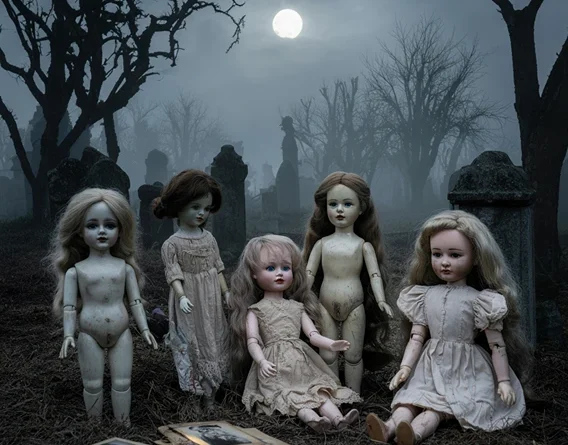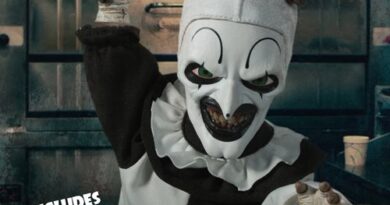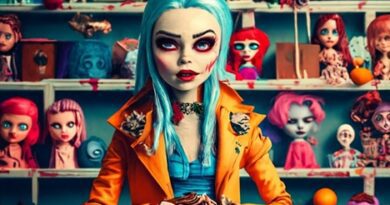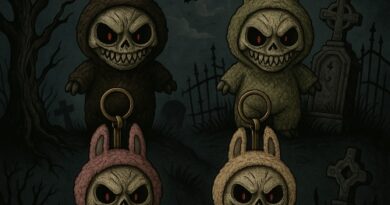Are The Living Dead Dolls by Mezco Toys Worth Staying Alive For?
It may have happened to you too, sometime between adolescence and adulthood: you sat with a few guys in the evening and tried to think of how you would conquer the world. At this stage, when there is almost always someone in the group trying to convince you that a junkfood resteraunt or a kiosk is the right directions (“Wow, bro! Cut the bullshit! Let’s open a stora and make a fortune”), only a few have successful ideas, and especially: only a few follow through with them, even years later.
A few decades ago, according to the stories, a similar incident occurred in a meeting between two friends: Ed Long and Damien Glonek. This conversation gave birth to one of the most successful and most prominent collectible lines ever, the Living Dead Dolls by Mezco Toys, which are here to stay. With a spooky gothic design (sometimes inspired by well-known horror characters), personalized backstories, and coffin-shaped packaging, these dolls have managed to create a unique niche that attracts not only horror fans but also collectors from other worlds looking for different and striking works of art, or just a cool item for their home or office.
Let’s delve into the history of Living Dead Dolls, their distinctive features, and the dolls that genuinely stand out in their extensive catalog.
What Are Living Dead Dolls?
The history of the Living Dead Dolls (or LDD for short) begins in the Long family home, somewhere in New Jersey. A guy named Ed Long (hereinafter “the creative”) took the dolls his mother made – mostly cute angel dolls – and decided to turn them into something truly terrifying. One day, his good friend Damien Glonek (whom we will call “the marketing brain”) suggested that he sell some dolls at his stand, which offered a different type of item altogether. Ed brought eight dolls, according to the stories, and managed to sell them on the first day. The two saw the potential and realized they should start producing more and more scary dolls, and do so quickly.
The first dolls were handmade on empty doll bodies, with customization done by Long and Glonek. They sold the dolls through Glonke’s mail-order company, “Unearthy Possessions,” and at various horror conferences that took place mainly on the East Coast of the United States. At one convention, the two met Mike “Mez” Markowitz, who founded “Mezco Toys” – today one of the largest companies producing action figures and collectibles – and is still considered the creative mind behind each one of its products.
“Mez” saw the dolls, became enthusiastic, and contacted the two about the potential for serial production and commercial distribution of the dolls. And the rest is history.
When Did Living Dead Dolls Come Out?
Under the leadership of “Mezco Toys,” the dolls went from being a small-scale craft item to a global phenomenon. The company maintained the original vision of the creators while also expanding it and allowing the dolls to reach new audiences.
One reason for the success may be that the dolls arrived at precisely the right time. At the time of their launch in 1998, we were witnessing a trend of appealing to teenagers or young adults, who were looking for branded, witty, and gothic items following the success of series like “Buffy the Vampire Slayer.” The Living Dead dolls fit into this seam, but were also unique and different even within the group of goth products that were common at the time, for example, in terms of clothing.
Another unusual characteristic was that the dolls were not closely tied to pop culture (such as products based on films or TV series), but rather grew independently. There have been several dolls based on real people, such as the murderer Lizzie Borden, but the emphasis has always been on representing them as dolls, not “real dead children.” Of course, this will change to some extent in the future, with collaborations and production licenses for existing brands.
Of course, over the years, the dolls have also sparked controversy: after all, these are dolls that represent dead people, including children. In 2002, the Greek government banned the marketing of the dolls in the country, claiming that they pose a “serious threat to the smooth formation and development of the child’s personality and mental health.” Other countries, such as Singapore or Ireland, have also considered restrictions on the dolls, with arguments that relate, among other things, to “public morality.”
The Characteristics Of The Living Dead Dolls
Although each Living Dead Doll has its own story and some unique characteristics, it is still possible to find apparent similarities between the dolls. The dolls are primarily made of plastic, with detailed cloth clothing, and stand approximately 10 inches tall (about 25 cm). The body is made of sturdy PVC plastic, while the clothes are crafted from delicate fabrics, including denim, velvet, and silk. Mezco Toys utilizes artificial fibers for the hair, and in some cases, natural hair is also incorporated into the doll. Glass or clear plastic is primarily used for the eyes.
Some of the dolls come with accessories that are included with the doll or can be purchased separately, such as weapons, jewelry, gothic pets, and other items related to the life story, or, if you prefer, items that relate to the circumstances of their death.
What’s no less exciting is that the dolls come in special coffin-style boxes, which include a plastic window through which you can see the doll (which means that quite a few collectors choose to keep the box). In each box, you’ll find a death certificate, which explains, in rhyme, how the specific doll “passed away.”
The dolls’ graphic design features a predominantly dark color palette, with an emphasis on shades such as black, gray, white, red, and metallic notes. The faces have a classic Gothic style, often featuring dark makeup, pale lips, and prominent eyes that convey a scary yet beautiful look.
How Many Living Dead Dolls Are There?
Today, LDD is the longest-running horror doll line in the world, with production continuing uninterrupted. To date, we are aware of approximately 35 series of dolls, and the number is still growing.
It started with the Sadie doll, the little girl who is”pining away, With her butcher’s knife, Coffin purse And black bouquet.” (accessories that come with the doll). Sadie’s cause of death is unknown, but the letter attached to the coffin and its design strongly suggest suicide. Sadie is based on Susan “Sadie” Atkins of the Manson gang – a character played in the film “Once Upon a Time in Hollywood” by Mikey Madison of “Scream,” Oscar winner for “Anora” – and also Wednesday Addams. Over the years, there have been multiple versions of Sadie, making her the doll with the most appearances in the series.
Another iconic doll from the first series is the character Damien, who, as you might guess, is a clear homage to the evil boy from the “The Omen” films. Damien, who comes equipped with a slingshot and three books (the Necronomicon, the 666 book, and a sulfur-symbol book), is the first male character in the series and the first with empty eyes. Over the years, Mezco Toys released several new versions of Damien, with different facial features and a tattoo commemorating the 13th day of death, as well as smaller versions.
The third classic character is Eggzorcist, a pun on “Exorcist.” It is a creepy girl in a bunny costume, with a basket of Easter eggs filled with candy, which also contains a cockroach. Eggzorcist was brutally hanged to death with a string used to tie rabbit ears. This doll was originally a handmade gift for a friend of one of the creators, who returned the gift after the relationship fell apart.
In the early years, you could request custom-made dolls, which, of course, significantly increased the price: custom-made dolls initially cost $666 per doll and later $800. In 2004, the creators decided to eliminate the option of customization or custom-made dolls. They do offer limited editions and one-off dolls today.
The Horror Icons Join The LDD Catalog
It’s too short to go into detail about each doll here. The bottom line is that in each such series, you will find dozens of characters, each with its own life and death story, as well as some complementary accessories. Most importantly: an interesting design that is genuinely creepy, even compared to other scary dolls we’ve already encountered on the site (well, except maybe dolls intended for children, like Huggy Wuggy or Labubu. What’s up with all these scary dolls for children?).
We’ve seen a few special editions, such as those commemorating the anniversary of a specific character or series that resurrect the dolls (Resurrection Series or Return of the Living Dead Doll), usually with some improvements and technological innovations, such as talking or light-up dolls. There have also been celebratory collections to mark the brand’s 20th anniversary.
Mazco Toys’ success with Living Dead Dolls has paved the way for collaboration with other major franchises and the development of new product lines. Under the name “Living Dead Doll Presents,” you can find dolls based on the biggest horror icons, such as:
- Jason Voorhees from “Friday the 13th,” including a version of his character from the 2009 remake
- Freddy Krueger from “A Nightmare on Elm Street”
- Chucky from “Child’s Play.” Like duh!
- Beetlejuice
- Ghostface from the “Scream” films
- Villains from “The Conjuring” cinematic universe, like The Nun and Annabelle
- Pennywise from the “It” films, both in Tim Carrey’s representation from the TV series and Bill Skarsgård’s recent representations from the two super successful films
- Edward Scissorhands from the Tim Burton masterpiece
- Characters from Rob Zombie’s “House of 1000 Corpses”, such as Otis and Captain Spaulding
- Michael Myers, including his appearance in “Halloween 2”
- Xenomorph from the “Alien” franchise
- The terrifying creature from the “Predator” films
- Nosferatu and his unfortunate victim
- Regan from “The Exorcist”
- Art the Clown and even the pale little girl from the second film in the “Terrifier” series
- Movie monsters, such as Godzilla and King Kong
- Wednesday Addams, including a character inspired by the dance scene we wrote about here
- Leatherface, the most famous villain of “The Texas Chainsaw Massacre”
In a way that perhaps corresponds with the trend of recent years, in which familiar fairy tales are taken (usually, after they have passed into the public domain) and turned into a horror movie (usually, terrible), there are some cool collections based on classic fairy tales and stories, such as:
- Beauty and the Beast
- Little Red Riding Hood
- Snow White and the Seven Dwarfs
- Hansel and Gretel
In addition to these characters, the company also creates special versions based on real historical figures, such as Lizzie Borden and Jack the Ripper, as well as characters from world folklore. Each franchise receives special and detailed treatment while maintaining the unique gothic aesthetic of the dolls and adding unique details that relate to the original character.
More Than Just Dolls
Over the years, Mezco Toys has significantly expanded the Living Dead Dolls line, now encompassing a diverse range of products and categories. Among other things, you can also find:
- 1:12 Scale dolls (One:12 Scale)
- Mini Figures
- Large Scale Figures and Mega Scale Figures
- Bobbleheads
- Plush Toys
- Statues
- Fashion products, such as shirts and socks
- Office supplies, such as pencil sharpeners and notebooks
In the coming years, Mezco Toys plans to continue expanding not only its doll catalog but also its digital presence, featuring accompanying apps, mobile games, and enhanced online shopping experiences.
Where To Buy Living Dead Dolls?
To our knowledge, there is currently no direct purchase option for LDD dolls in many countries worldwide, and the company does not have an official presence in a significant number of countries.
This does not mean, of course, that there is no way to get your hands on them. In addition to the official Mezco Toys website, you can find the dolls on prominent international shopping sites, such as:
Please pay attention to whether the site offers shipping to your location and, of course, what their shipping price is. LDD dolls are not inexpensive – the price starts at a few dozen dollars for each doll – and it would be a shame to increase the purchase price with astronomical shipping costs significantly.




